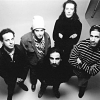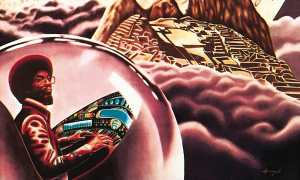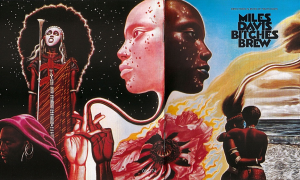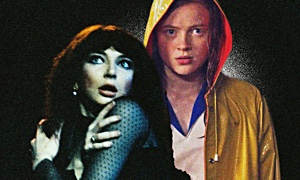Home » Jazz Articles » Rediscovery » Lost Tribe: Lost Tribe
Lost Tribe: Lost Tribe
 Lost Tribe
Lost TribeLost Tribe
Windham Hill Jazz
1993
Today's Rediscovery ultimately jumpstarted the careers of five young musicians who have since gone on to varying degrees of greater fame and exposure. While not necessarily household names, few who follow the contemporary jazz scene will be unaware of saxophonist David Binney, guitarists Adam Rogers and David Gilmore, bassist Fima Ephron and drummer Ben Perowsky. Together, as Lost Tribe, the quintet released a stunning debut on Windham Hill Jazz that also laid waste to claims that the label's focus was new agey ramblings and easy-on-the-ears solo music by artists like George Winston, William Ackerman and Alex de Grassi. If anything, Lost Tribe is as hardcore as it gets, released at a time of smooth jazz and neo-conservatism, that blends aggressive, pedal-to-the-metal fusion, unrelenting funk and even hints of hip hop and rap.
Of the five, Binney is the one to garner, perhaps, the greatest acclaim as a composer...so much so that his equally impressive acumen as a saxophonist is sometimes overlooked. Albums like South (ACT, 2003), Graylen Epicenter (Mythology, 2011) and, in particular, 2014's career pinnacle Anacapa (Criss Cross) have reinforced Binney's ever-growing reputation as one of the more influential composers of his generation. Defined by sometimes knotty yet somehow always memorable thematic constructs layered over complex polyrhythmic foundations, Binney's music may challenge but, more often than not, manages to remain somehow strangely accessible. Still, as he has been making clear on more recent records like Lifted Land (Criss Cross, 2013)—but, in reality, dating right back to Lost Tribe's 1993 debut—he's a saxophonist with plenty to offer, too.
Rogers' discography as a leader is significantly smaller, but his work with everyone from Chris Potter (including the saxophonist's outstanding 2015 ECM recording Imaginary Cities) and Randy Brecker to Norah Jones and, as heard most recently at the 2013 Festival International de Jazz de Montréal, Ravi Coltrane—in addition to superb solo outings like Apparitions (Criss Cross)—have proven the guitarist a frighteningly diverse player as comfortable with a nylon-string instrument as he is the more densely overdriven electric favored on Lost Tribe.
Like Rogers, Gilmore's own body of work is relatively small, but his collaborations with others—including cutting his teeth with Steve Coleman and the whole M-Base crowd, as well as longstanding relationships like that with Don Byron (last heard on the clarinetist/saxophonist's 2006 Blue Note Junior Walker tribute, Doin' the Boomerang)—amply demonstrate another guitarist whose versatility and, like Rogers, stunning technique and big ears make almost anything possible.
Ephron's career has largely been more left of center, affiliated with John Zorn's Tzadik label through his tenure with the groundbreaking Hasidic New Wave; but he's also remained affiliated with a more rock-edged fusion extreme via guitarist David Fiuczynski's Screaming Headless Torsos. Perowsky, on the other hand, has built a career out of rampant diversity, sitting behind the kit with everyone from Mike Stern, Dave Douglas and John Zorn to Rez Abbasi, Uri Caine and Salif Keita—a résumé that truly speaks for itself.
Despite being an egalitarian collective with compositions contributed by everyone in the band, Binney still contributes the relative lion's share, with four tracks to the other members' two each. From his frenetic opener, "Mythology—where a rapid-fire guitar line and fast funk groove drive Binney's sharp, staccato theme—to the slower-paced, wonderfully chord-driven "Dick Tracy" that follows, with its longer-toned theme and a solo section built around a repeating ascending riff where Rogers' fuzz-toned questions are answered by Gilmore's pianistic guitar synth, these are the one-two punch that introduces Lost Tribe as a group of no constraint, few rules...and zero compromise.
Other highlights include Ephron's lyrical ballad, "Procession," its swelling guitar chords and textural drumming creating a gentle, ethereal cushion over which Binney takes a spare solo pure of tone and compositionally connected to what's happening around him. While Perowksy's hip hop-inflected "Letter to the Editor," complete with rap, seemed like a weak spot at the time for jazz fans who rankled at the stylistic intrusion, time has proven much kinder. Gilmore's thundering, riff-driven "Eargasm" reflects the mathematical designs of M-Base, but like the rest of the record, it manages to somehow fit within the group's overall purview; as different as every writer in the band was then (and is now), the whole thing sounds like nothing but Lost Tribe.
Rogers' ambling "Rhinoceros" and more up-tempo and idiosyncratic "Mofungo" are two additional highlights....but heck, the truth is: every track on Lost Tribe is a winner. Produced by Steely Dan's Walter Becker, Lost Tribe garnered more than enough critical and popular attention to warrant 1994's similarly impressive follow-up, Soul Fish (Windham Hill Jazz). It was early days for everyone, but they were already demonstrating the qualities that would lead them into becoming in-demand and influential players and (especially in Binney's case) composers over the next two decades.
As their individual careers began to pick up steam, Many Lifetimes (Arabesque) reunited the group (but without Gilmour) four later, but was unfairly criticized for being more subdued in tone; the truth, however, is that it simply reflected the maturity and growth its remaining four members had undergone in those intervening years.
Despite Lost Tribe reuniting for a show at Matthew Garrison's Shapeshifter Labs in 2013, occasional rumours of a more full-fledged Lost Tribe reunion remain just that. Still, it's reason enough to return to Lost Tribe, where five stellar careers began. With 60 minutes of groundbreaking, electrified music as exhilarating today as 22 years prior, Lost Tribe is the quintessential Rediscovery.
Tracks: Mythology; Dick Tracy; Procession; Letter To The Editor; Eargazm; Rhinoceros; Mofungo; Space; Four Directions; Fool For Thought; T.A. the W. (Tender as the Wind); Cause and Effect.
Personnel: Ben Perowsky: drums, percussion, samples, rap; Adam Rogers: guitar; Fima Ephron: bass; David Binney: alto saxophone; David Gilmore: guitar, guitar synthesiser.
So, what are your thoughts? Do you know this record, and if so, how do you feel about it?
[Note: You can read the genesis of this Rediscovery column here.]
< Previous
After the Tempest
Comments
About Lost Tribe
Instrument: Band / ensemble / orchestra
Related Articles | Concerts | Albums | Photos | Similar ToTags
Lost Tribe
Rediscovery
John Kelman
United States
New York
New York City
David Binney
Adam Rogers
David Gilmore
Fima Ephron
Ben Perowsky
George Winston
Alex De Grassi
Chris Potter
randy brecker
Norah Jones
Ravi Coltrane
Steve Coleman
Don Byron
John Zorn
David Fiuczynski
Mike Stern
Dave Douglas
Rez Abbasi
Uri Caine
Salif Keita
steely dan
Walter Becker
Matthew Garrison
For the Love of Jazz
 All About Jazz has been a pillar of jazz since 1995, championing it as an art form and, more importantly, supporting the musicians who create it. Our enduring commitment has made "AAJ" one of the most culturally important websites of its kind, read by hundreds of thousands of fans, musicians and industry figures every month.
All About Jazz has been a pillar of jazz since 1995, championing it as an art form and, more importantly, supporting the musicians who create it. Our enduring commitment has made "AAJ" one of the most culturally important websites of its kind, read by hundreds of thousands of fans, musicians and industry figures every month.
























